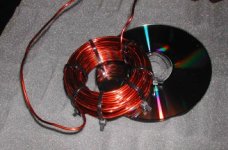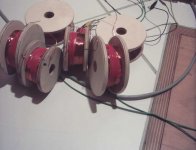After following a link from a link, and due to the inavailability of sufficient inductors from my local store, I decided to whip up a couple myself..... I decided to go for something big..... 2mm wire (makes a 0.33mH coil at 0.08 ohm) for the woofers
steps
1. find the wire! - easy to buy in 100g (0.2lb) or 40kg (90lb) spools..... trickier to get just a kg or 2.....
2. make a form....... used some 50mm PVC pipe, a holesaw and some mdf offcuts
3. wind it! - I have no skin left on my index finger from holding the 2mm copper tight for 1/2hr
4. test it - unwind, checking inductance as you go, not as simple as it sounds - each time you cut some off you need to scrape off the enamel so the DMM can test it.....
5. get it off the form in one piece!
6. admire your work (not the prettiest, but weighs in at 0.33mH and 450g (1lb)) hopefully will do the trick nicely - I think my multimeter is a dud - it gives its resistance as 0.3ohm, the same as when I short the clips together! I assume its R is closer to the 0.08 quoted above...... with this wire it is rated to about 700W ! yee-ha
- I think my multimeter is a dud - it gives its resistance as 0.3ohm, the same as when I short the clips together! I assume its R is closer to the 0.08 quoted above...... with this wire it is rated to about 700W ! yee-ha
steps
1. find the wire! - easy to buy in 100g (0.2lb) or 40kg (90lb) spools..... trickier to get just a kg or 2.....
2. make a form....... used some 50mm PVC pipe, a holesaw and some mdf offcuts
3. wind it! - I have no skin left on my index finger from holding the 2mm copper tight for 1/2hr
4. test it - unwind, checking inductance as you go, not as simple as it sounds - each time you cut some off you need to scrape off the enamel so the DMM can test it.....
5. get it off the form in one piece!
6. admire your work (not the prettiest, but weighs in at 0.33mH and 450g (1lb)) hopefully will do the trick nicely
Attachments
Calibration???????
You would think they would at least allow you to calibrate the thing then ....... I should remember to subtract 0.3ohm from future r readings.
Gee they must use cheap and nasty leads, if 15m of copper can have a r of 0.08, then the lousy 2 foot long leads should be able to be better than 0.3 surely.....
I guess I got what I paid for.....
You would think they would at least allow you to calibrate the thing then ....... I should remember to subtract 0.3ohm from future r readings.
Gee they must use cheap and nasty leads, if 15m of copper can have a r of 0.08, then the lousy 2 foot long leads should be able to be better than 0.3 surely.....
I guess I got what I paid for.....
plasmodium said:1. find the wire! - easy to buy in 100g (0.2lb) or 40kg (90lb) spools..... trickier to get just a kg or 2.....
You could also pay a motor/transformer winding firm a visit.
DIY inductors are very cost effective but beware that your ability to get accurate mH value can vary by a significant amount. In my experience using a cheap AU$100 Jaycar multimeter I found variations of as much as 17% on a 1.8mH (1.8mm dia wire). It also seems to vary at what temperature/time of the day. Maybe its just my meter problems. But for example my shop inductors (1.8mm) 0.83mH reads 0.68mH and 1.8mH reads 1.62mH At first I thought the shop had sent me the wrong values, but upon further investigation I was told by other transformer shops that the cheap hobby mulitmeters are designed to be accurate for small gauge wire of around 0.8mm commonly used by hobbiests. Accurate measurements are usually done by more sophisticated methods and meters.
I related this experienced to somebody else and he also found similar variation using his Dick Smith multimeter, believing his 1.8mH DIY coil which later turned out to be 2mH.
Have others here had this kind of experience?
I related this experienced to somebody else and he also found similar variation using his Dick Smith multimeter, believing his 1.8mH DIY coil which later turned out to be 2mH.
Have others here had this kind of experience?
till,
do you manually guide the wire while it's winding? My gut feeling tell me that if the wire roll is far enough from the bobbin and wire tension is about right, then the process should be automatic (winding with perfect layer).
I'm using manual hand crack to wind wire and I find it hard to make a perfect layer more than 6/7 layers. No matter what I do there always be gaps.
Could you take a picture of your bobbin installed in your lathe? Best yet could you take a picture of it when it's in action ?
I appreciate it. Thanks !
do you manually guide the wire while it's winding? My gut feeling tell me that if the wire roll is far enough from the bobbin and wire tension is about right, then the process should be automatic (winding with perfect layer).
I'm using manual hand crack to wind wire and I find it hard to make a perfect layer more than 6/7 layers. No matter what I do there always be gaps.
Could you take a picture of your bobbin installed in your lathe? Best yet could you take a picture of it when it's in action ?
I appreciate it. Thanks !
Santoso, theses are not really perfect, i have some gaps also. I guided the wire manually, you need strong fingers to do this because you have to pull very strong against the lathe. I had the spool with all the wire on it behind me, i stand in front of the lathe, in my back a latter with a broomstick through it, on the stick the copper coil. I pulling with gloves strong on the wire against the turning lathe. Another person needs to be present for counting the turns. (no turn counther installed)
I did not care for they are absolutely perfect. I think a spool with more than one layer is always a little non regular.
I did not care for they are absolutely perfect. I think a spool with more than one layer is always a little non regular.
Till,
I manage to get a steady tension simply by 'clamping' the wire between 2 small cut mdf with 2 bolts and wingnuts.
I create a runner on one of the mdf pieces serve as wire guide. To adjust the tension I simply play around with the wingnuts.
Therefore, I only need to guide the wire left or right avoiding blisters
I manage to get a steady tension simply by 'clamping' the wire between 2 small cut mdf with 2 bolts and wingnuts.
I create a runner on one of the mdf pieces serve as wire guide. To adjust the tension I simply play around with the wingnuts.
Therefore, I only need to guide the wire left or right avoiding blisters
- Status
- This old topic is closed. If you want to reopen this topic, contact a moderator using the "Report Post" button.
- Home
- Loudspeakers
- Multi-Way
- homemade inductor - sheesh!!

